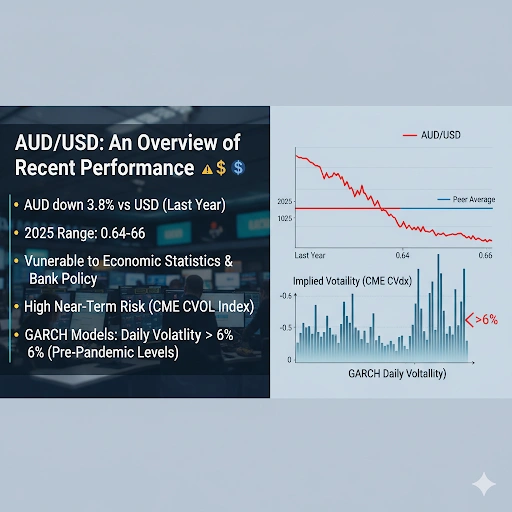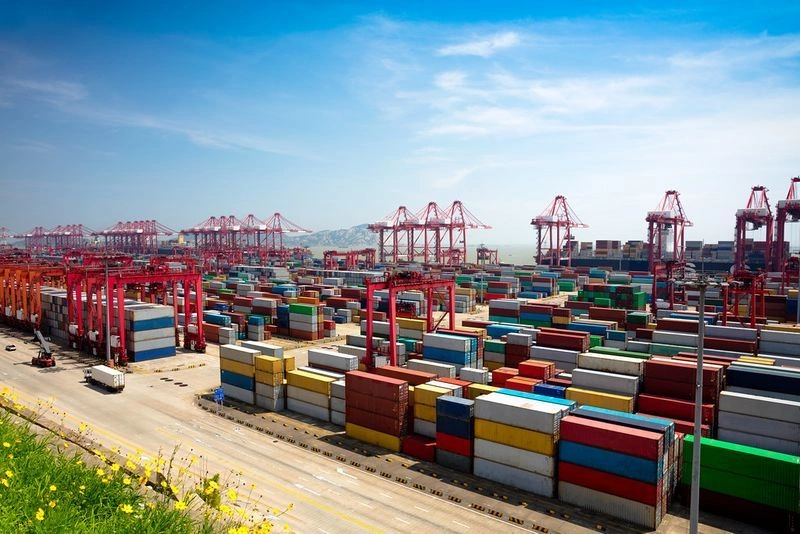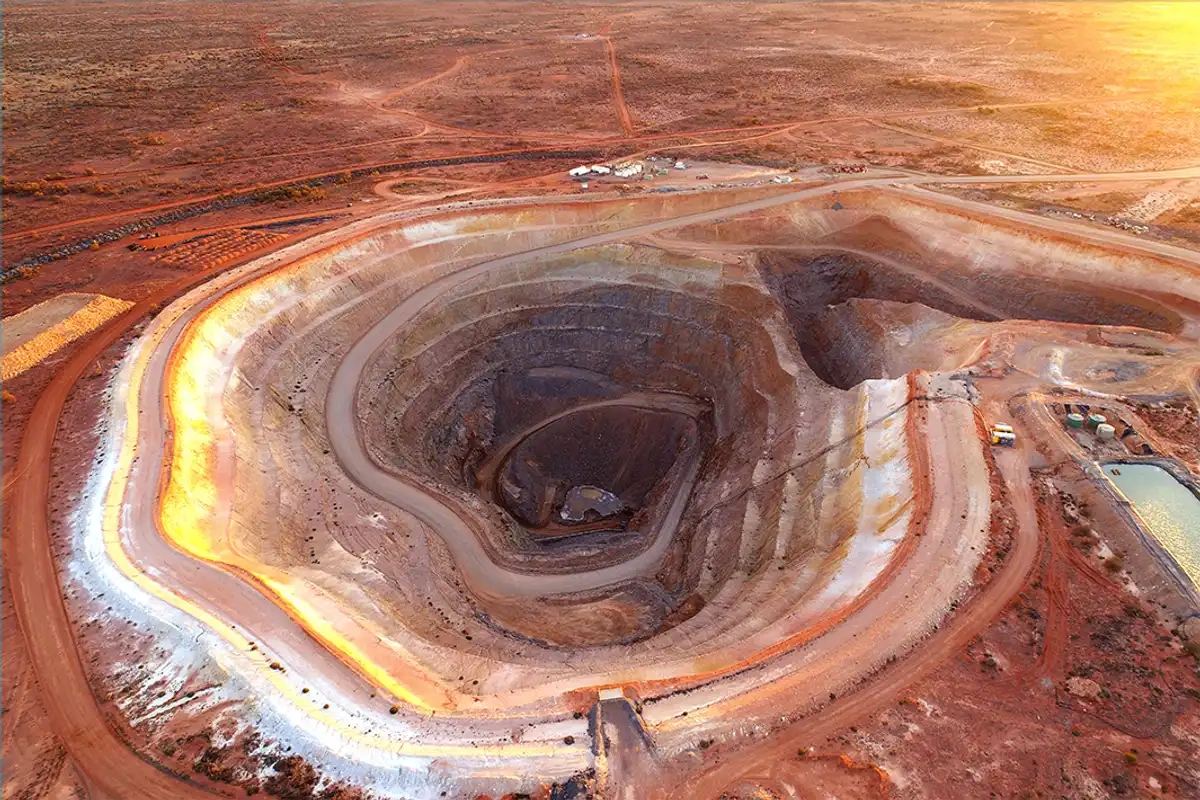Recent months have witnessed an increased volatility of the Australian dollar (AUD) relative to the US dollar (USD), a phenomenon of fluctuation of interest rate expectations and commodity price fluctuations, and the sentiment of the world investors. As the AUD/USD trades at 0.6592, or midway between its recent range, the currency pair has become a core focus for markets because of the significance it has in the flow of trade and the performance of the resource sector. To the mining firms in Australia, currency fluctuations have tangible implications – determining revenues, margins, and investor attitudes.
AUD/USD: An overview of the recent performance
Compared to most of its peers, AUD has lost almost 3.8% over the last year against the USD. In the course of 2025, the two have moved in a range of 0.64- 0.66, highlighting their vulnerability to world economic statistics and bank policy indicators. The implied volatility, e.g., the CME index of CVOL, indicates high-risk expectations in the near-term, whereas GARCH-based models indicate the possibility of daily volatility exceeding 6 percent, which is significantly higher than the pre-pandemic levels.
 The Australian dollar has traded between 0.64 and 0.66 against the US dollar in recent months.
The Australian dollar has traded between 0.64 and 0.66 against the US dollar in recent months.
Major Forces that underlie the Volatility
Interest Rate Differentials
One of the major contributors to AUD/USD has been changing monetary policy expectations. The Reserve Bank of Australia (RBA) has taken the conservative approach and maintained the rates constant, although it is an indication that the bank is paying special attention to inflation. On the other hand, the US Federal Reserve has reverted to its acceleration and the USD has comparatively supported. Any change in these directions contributes to volatility as traders reset the interest rate differentials.
Price Volatility of Commodities
The economy and the currency system of Australia are closely interconnected with the world commodity markets. Iron ore, coal, and base metals are traded in USD and thus AUD/USD is very sensitive to the commodity prices markets. The recent fragility in iron ore prices, which has been pegged on the slow real estate situation in China, has been a drag on the AUD. In the meantime, the strength of gold has been a source of relief, especially to the gold miners in Australia.
 Commodity prices, especially iron ore, remain a key driver of AUD/USD volatility
Commodity prices, especially iron ore, remain a key driver of AUD/USD volatility
China’s Economic Outlook
China is the largest export market of Australia. The Chinese manufacturing and construction data have been weak, with a modest policy stimulus, which has led to the dampening of the demand expectations of Australian raw materials. There has been a response to every data release by Beijing to AUD/USD, indicating how this currency has become a proxy for Chinese growth prospects.
 China’s manufacturing and construction activity strongly influences Australian dollar performance.
China’s manufacturing and construction activity strongly influences Australian dollar performance.
Global Risk Sentiment
AUD is a so-called risk currency, which is doing well when the global economy shows signs of expansion and facing a withdrawal when investors are afraid of hiding in safe havens. Recent changes of mood, in favor of Fed easing and against global expansion, have solidified the weakness of the currency.
The Exchange Rate is important to Australia
Movements in currencies have direct effects on inflation, balance of trade, and investor confidence. To importers, a weak AUD increases the prices of machinery, fuel, and consumer goods. To exporters, especially those in the mining sector, the softening of the AUD makes them more competitive and raises the Australian-dollar value of the USD-denominated revenues. These advantages, however, can be offset by the increased expenses of imported inputs.
The Implication on Mining Companies.
The benefits of Revenue translation
The majority of the Australian miners exchange their commodities in USD. A lower AUD converts such earnings into more local currency, which increases reported revenues and margins. To illustrate, when the price of iron ore is USD 100/ tonne, an AUD 153.85 would be obtained at an exchange rate of 0.65, but AUD 166.67 when the currency decreases to 0.60. This currency leverage may have a big impact on profits.
 Gold miners benefit from a weaker AUD when converting USD revenues into local currency.
Gold miners benefit from a weaker AUD when converting USD revenues into local currency.
Cost Pressures
Although revenues will appreciate due to a weaker AUD, a lot of input costs will increase. Mining tools, spare parts, and fuel are usually imported and billed using USD or euros. The effect of currency depreciation consequently increases the cost of operation, which partially counters the increase in revenue.
Financial Strategy and Hedging
Unstable exchange rates make hedging more challenging. Whereas a few miners employ layered or optional hedges to mollify earnings, the increased FX volatility increases the cost of hedging. Firms that do not match hedges and the reality exposures are prone to crystallize the losses.
Investor Sentiment
The mining sector is also subject to currency swings, which impact the perception of the investors. A lower AUD is usually viewed as positive for the earnings of miners, which causes share price surges. On the other hand, a high AUD, unless supported by higher commodity prices, may squeeze margins and create a burden to valuations.
Recent Sector Developments
Stress has already manifested itself in the mining sector. The declining demand and the increasing royalty have put coal producers under pressure, which has caused the closure of pits and loss of jobs. Simultaneously, gold miners have enjoyed both an upsurge in USD gold prices and a weak AUD, boosting local-currency revenues. The sensitivity to the exchange rate movements has also been increased due to policy disputes, such as tax and fiscal forecasts.
Bullish Future of AUD/USD and Mining
Currency Projections
Analysts are divided as to the direction of the AUD. Others, such as Commonwealth Bank, forecast a slow recovery to 0.72 in case the Fed hastens the reduction of rates and the economy across the world begins to stabilise. Some are warning that any rise would be capped by consistent weakness in China and another surge of the USD.
Strategic Advice to Miners
- Responsiveness to hedging: Use dynamic hedging strategies to compromise protection of revenue and exposure to possible upside in currencies.
- Management of costs: Reduce dependence on imported inputs by localisation where it is feasible.
- Scenario planning: Simulate both commodity and currency volatility to determine profitability in a stressful environment.
- Capital discipline: Do not become over-levered during times of increased FX risk.
- Market watching: Pay close attention to the advancements of the US monetary policy and Chinese demand, as they have their disproportionate impact on AUD/USD.
Also Read: Women in Australian Mining: Advancements and Initiatives
Final Thoughts
The fluctuation in AUD/USD highlights the interdependence of the currency markets, international commodities, and the Australian mining industry. Although a weaker AUD usually helps the exporters to boost their revenues, increasing input prices and intricate hedging arrangements constrain the benefits.
In the case of miners, currency exposure is an issue of relevance as much as commodity prices. The Australian dollar will continue to be volatile with global uncertainties high, and as such, firm financial strategies are crucial in staying competitive in the sector.
FAQs
1: Why is the Australian dollar volatile against the US dollar?
The AUD/USD is influenced by interest rate differentials, commodity prices, China’s demand outlook, and global risk sentiment.
2: How does a weaker Australian dollar affect mining companies?
A weaker AUD boosts miners’ revenues by increasing the local value of USD-denominated exports, but it also raises import costs for fuel and equipment.
3: What role does China play in AUD/USD movements?
China is Australia’s largest export market. Weak demand or stimulus from China directly impacts commodity demand, influencing the Australian dollar.
4: Why do investors watch AUD/USD when assessing mining stocks?
Mining revenues are tied to USD commodity prices. Currency shifts affect profitability and valuations, making AUD/USD a key indicator for investors.
5: What is the outlook for AUD/USD in 2025?
Analysts project potential recovery toward 0.72 if US rate cuts accelerate, but weakness in China and strong USD demand could limit gains.












